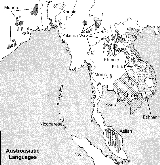
Peopling of Laos
Encyclopedia
The Peopling of Laos refers to the process by which the ethnic groups that comprise the population
of present-day Laos
came to inhabit the region. Aside from ethnic groups representing recent expatriate migrations, the ethnic groups of Laos are all believed to be descended from ethnicities associated with clades of Y-DNA Haplogroup O
, suggesting an ancient homogeneous ethnicity in China some 35,000 years ago which, over time, spread out and independently evolved into diverse sub-ethnicities, branches of which found their way to Laos at different points in history, employing different migration routes and modes of transportation, only after being infused with elements of other cultures along the way, via both exposure and inter-breeding. The result is an extremely diverse population of distantly related tribes with a common Asian heritage steeped in ancient tradition.
with a homeland somewhere within the borders of the modern-day Peoples Republic of China. The prevalence of Y-DNA Haplogroup O
among Austro-Asiatic peoples suggests a common ancestry with the Sino-Tibetan
, Austronesian
and Hmong–Mien peoples some 35,000 years ago in China. Haplogroup O is a clade
of Y-DNA Haplogroup K
which is believed to have originated 40,000 somewhere between Iran and Central China. In addition to the ethnicities previously mentioned, the progenitor of Haplogroup K was probably the ancestor of nearly all modern Melanesian people
, as well as the Mongols
and the Native Americans
. Haplogroup K, in turn, is a clade of Y-DNA Haplogroup F, which is believed to have originated in Northern Africa some 45,000 years ago. Haplogroup F is believed to be associated with the second major wave of migration out of the African continent. In addition to the ethnicities previously mentioned, the progenitor of Haplogroup F was probably the ancestor of all Indo-Europeans
.
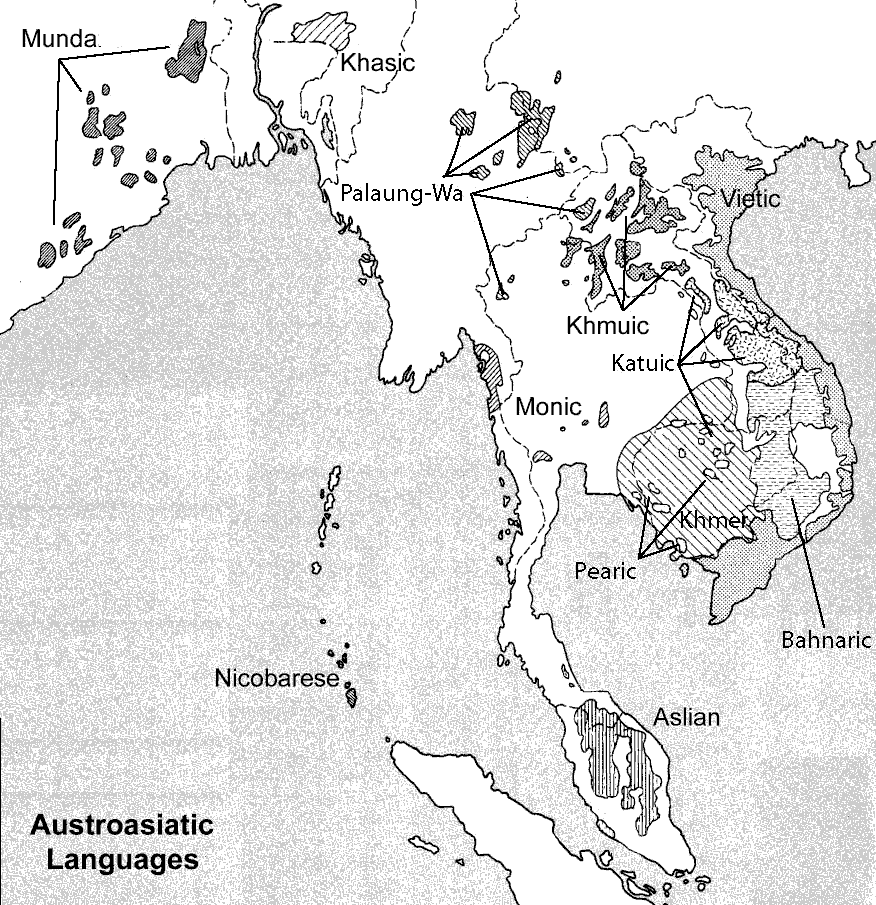 Like the Khmuic, the Mon–Khmer ethnicities were among the earliest aboriginal populations in Southeast Asia. The arrival of these ethnic groups likely represents the second wave of settlement in Laos, although considerable inter-Southeast-Asian migration has taken place since their arrival, especially during the prevalence of the Khmer Empire
Like the Khmuic, the Mon–Khmer ethnicities were among the earliest aboriginal populations in Southeast Asia. The arrival of these ethnic groups likely represents the second wave of settlement in Laos, although considerable inter-Southeast-Asian migration has taken place since their arrival, especially during the prevalence of the Khmer Empire
in Thailand. Archaeologists suspect that the Mon–Khmer may have spread through Laos
throughout the metal ages, bringing rice agriculture, metalworking, domestic animals, and the Mon–Khmer languages to the region. They are believed to have spread through Southeast Asia from west to east along the coast, and then subsequently migrated inland along the rivers, long before the arrival of the now dominant Tai
peoples.
and Cambodia
.
), the expansion of individual tribal populations, and the threats imposed by other civilizations in the region. Also, in early days, the Austro-Asiatic were a hunter-gatherer civilization, a lifestyle which lends itself to continuous migration. Along with this ongoing intra-regional migration, there has been considerable cross-cultural inter-marriage over the years between the Mon–Khmer peoples and other Southeast Asian civilizations, resulting in a Mon–Khmer population very different in both physical appearance and culture from other branches of the Austro-Asiatic ethnic tree who migrated elsewhere. Likewise, Mon–Khmer have largely assimilated into the later-arriving dominant Tai population in Laos, beginning at an early stage in the region's history, thereby infusing their culture and genetics into the modern Lao people.
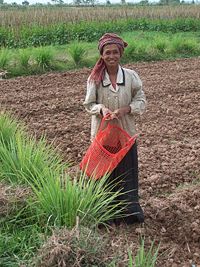 Since the Mon–Khmer were aboriginal to the region, there is great ethnic diversity among the individual ethnic groups. The following Mon–Khmer ethnic groups currently reside in Laos:
Since the Mon–Khmer were aboriginal to the region, there is great ethnic diversity among the individual ethnic groups. The following Mon–Khmer ethnic groups currently reside in Laos:
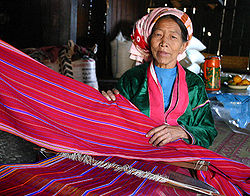 The Palaungic people are indigenous Southeast Asians. The center of their population cluster is in present-day Burma and neighboring regions of China.
The Palaungic people are indigenous Southeast Asians. The center of their population cluster is in present-day Burma and neighboring regions of China.
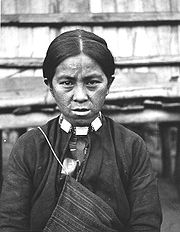 Comparative linguistic research indicates that the Tai
Comparative linguistic research indicates that the Tai
people were a Tai–Kadai-speaking culture of southern China, and that they, like the Malay-Polynesians, may have originally been of Austronesian descent. Prior to inhabiting mainland China, the Tai are suspected to have migrated from a homeland on the island of Taiwan
where they spoke an early Austronesian dialect. After the arrival of Sino-Tibetan speaking ethnic groups from mainland China to the island of Taiwan, the Tai would have then migrated into mainland China, perhaps along the Pearl River
, where their language greatly changed in character from the other Austronesian languages under influence of Sino-Tibetan and Hmong–Mien language infusion. The coming of the Han Chinese
to this region of southern China may have prompted the Tai to migrate in mass once again, this time southward over the mountains of southern China into Southeast Asia via the mountains of Burma and Laos
to the north of Thailand
. It is believed that the Tai ethnic groups began migrating southward from China and into Southeast Asia during the first millennium A.D. While this theory of the origin of the Tai is currently the leading theory, there is insufficient archaeological evidence to prove or disprove the proposition at this time, and the linguistic evidence alone is not conclusive. However, in further support of the theory, it is believed that the O1 Y-DNA haplogroup
is associated with both the Austronesian people
and the Tai.
, and has resulted in a Tai population significantly different in culture, language and physical appearance from the Tai ethnic groups who remained in China. In addition, many of the individual Tai ethnic groups have merged under a common Laotian identity, and have adopted a nationalistic view of their culture.
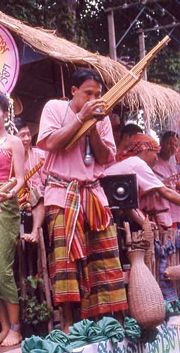 There are numerous distinct Tai ethnic groups within Laos, making up an overwhelming majority of the nation's population. The genetic stratification of the ethnic clades of the Tai ethnicity is a topic of present debate among linguists and other social scientists. A list of the Tai ethnic groups of significant size within Laos are as follows:
There are numerous distinct Tai ethnic groups within Laos, making up an overwhelming majority of the nation's population. The genetic stratification of the ethnic clades of the Tai ethnicity is a topic of present debate among linguists and other social scientists. A list of the Tai ethnic groups of significant size within Laos are as follows:
 The Hmong–Mien generally migrated from China into Laos over a wide time span. An exception is the Iu Mien
The Hmong–Mien generally migrated from China into Laos over a wide time span. An exception is the Iu Mien
people, who apparently passed through Vietnam during the thirteenth century, prior to entering Laos.
, where they settled least 2000 years ago.
immigration to Laos
dates back many centuries, and the specific Chinese ethnic groups which made their way to Laos are numerous, although there is a greater concentration of Chinese from the southern provinces due to their geographic proximity to Laos.
ancestry, and are therefore distantly related to the Tibeto-Burman
people.
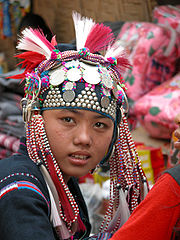 The Lolo are believed to be descended from the ancient Qiang people of western China
The Lolo are believed to be descended from the ancient Qiang people of western China
, who are also said to be the ancestors of the Tibetan
, Naxi and Qiang peoples. They migrated from Southeastern Tibet
through Sichuan and into Yunnan Province, where their largest populations can be found today.
(also commonly referred to as the Yi) is one of the two distinct Tibeto-Burmese ethnicities within present-day Laos, along with the Kado. The Lolo are believed to have migrated southeast from Burma into Laos and Thailand.
people, distantly related to the Lolo.
Population
A population is all the organisms that both belong to the same group or species and live in the same geographical area. The area that is used to define a sexual population is such that inter-breeding is possible between any pair within the area and more probable than cross-breeding with individuals...
of present-day Laos
Laos
Laos Lao: ສາທາລະນະລັດ ປະຊາທິປະໄຕ ປະຊາຊົນລາວ Sathalanalat Paxathipatai Paxaxon Lao, officially the Lao People's Democratic Republic, is a landlocked country in Southeast Asia, bordered by Burma and China to the northwest, Vietnam to the east, Cambodia to the south and Thailand to the west...
came to inhabit the region. Aside from ethnic groups representing recent expatriate migrations, the ethnic groups of Laos are all believed to be descended from ethnicities associated with clades of Y-DNA Haplogroup O
Haplogroup O (Y-DNA)
In human genetics, Haplogroup O is a Y-chromosome DNA haplogroup. Haplogroup O is a close cladistic brother group with Haplogroup N, and is one of several descendants of Haplogroup K ....
, suggesting an ancient homogeneous ethnicity in China some 35,000 years ago which, over time, spread out and independently evolved into diverse sub-ethnicities, branches of which found their way to Laos at different points in history, employing different migration routes and modes of transportation, only after being infused with elements of other cultures along the way, via both exposure and inter-breeding. The result is an extremely diverse population of distantly related tribes with a common Asian heritage steeped in ancient tradition.
Early arrival of the aboriginal Khmuic people
The Khmuic people were among the first populations to settle in Laos. They were by and large absorbed by the later arriving Mon–Khmer and Tai ethnicities, except for small populations that migrated to the mountainous regions of Laos during the Tai migration into the region.Origin of the Khmuic
The Khmuic are an Austro-Asiatic people, distantly related to the nuclear Mon–Khmer people. They are believed to have migrated by land from China to Laos, where they have resided for at least 4,000 years. Some 10,000 years ago, they were probably part of a largely homogenous ethnicity now referred to as the Austro-Asiatic peoplesAustro-Asiatic languages
The Austro-Asiatic languages, in recent classifications synonymous with Mon–Khmer, are a large language family of Southeast Asia, also scattered throughout India and Bangladesh. The name Austro-Asiatic comes from the Latin words for "south" and "Asia", hence "South Asia"...
with a homeland somewhere within the borders of the modern-day Peoples Republic of China. The prevalence of Y-DNA Haplogroup O
Haplogroup O (Y-DNA)
In human genetics, Haplogroup O is a Y-chromosome DNA haplogroup. Haplogroup O is a close cladistic brother group with Haplogroup N, and is one of several descendants of Haplogroup K ....
among Austro-Asiatic peoples suggests a common ancestry with the Sino-Tibetan
Sino-Tibetan languages
The Sino-Tibetan languages are a language family comprising, at least, the Chinese and the Tibeto-Burman languages, including some 250 languages of East Asia, Southeast Asia and parts of South Asia. They are second only to the Indo-European languages in terms of the number of native speakers...
, Austronesian
Austronesian people
The Austronesian-speaking peoples are various populations in Oceania and Southeast Asia that speak languages of the Austronesian family. They include Taiwanese aborigines; the majority ethnic groups of East Timor, Indonesia, Malaysia, the Philippines, Brunei, Madagascar, Micronesia, and Polynesia,...
and Hmong–Mien peoples some 35,000 years ago in China. Haplogroup O is a clade
Clade
A clade is a group consisting of a species and all its descendants. In the terms of biological systematics, a clade is a single "branch" on the "tree of life". The idea that such a "natural group" of organisms should be grouped together and given a taxonomic name is central to biological...
of Y-DNA Haplogroup K
Haplogroup K (Y-DNA)
In human genetics, Haplogroup K is a Human Y-chromosome DNA haplogroup. This haplogroup is a descendant of Haplogroup IJK. Its major descendant haplogroups are Haplogroup LT and Haplogroup K...
which is believed to have originated 40,000 somewhere between Iran and Central China. In addition to the ethnicities previously mentioned, the progenitor of Haplogroup K was probably the ancestor of nearly all modern Melanesian people
Melanesia
Melanesia is a subregion of Oceania extending from the western end of the Pacific Ocean to the Arafura Sea, and eastward to Fiji. The region comprises most of the islands immediately north and northeast of Australia...
, as well as the Mongols
Mongols
Mongols ) are a Central-East Asian ethnic group that lives mainly in the countries of Mongolia, China, and Russia. In China, ethnic Mongols can be found mainly in the central north region of China such as Inner Mongolia...
and the Native Americans
Indigenous peoples of the Americas
The indigenous peoples of the Americas are the pre-Columbian inhabitants of North and South America, their descendants and other ethnic groups who are identified with those peoples. Indigenous peoples are known in Canada as Aboriginal peoples, and in the United States as Native Americans...
. Haplogroup K, in turn, is a clade of Y-DNA Haplogroup F, which is believed to have originated in Northern Africa some 45,000 years ago. Haplogroup F is believed to be associated with the second major wave of migration out of the African continent. In addition to the ethnicities previously mentioned, the progenitor of Haplogroup F was probably the ancestor of all Indo-Europeans
Indo-European languages
The Indo-European languages are a family of several hundred related languages and dialects, including most major current languages of Europe, the Iranian plateau, and South Asia and also historically predominant in Anatolia...
.
Individual Khmuic ethnic groups in Laos
The following is a list of Khmuic ethnic groups of significant size in Laos:- KhmuKhmu peopleThe Khmu is one of the largest ethnic groups based in northern Laos. They can also be found in Burma, southwest China , Thailand, and Vietnam, where they are an officially recognized ethnic group...
(Population of 389,694 in Laos) - KhuenKhuen peopleThe Khuen people are an aboriginal ethnic group of Laos.-Name Variation:The Khuen have appeared in research under several different English spellings including Khuen, Kuan, Kuanhua, Kween, Khween, and Khouen.-Language:...
(Population of 8,000 in Laos) - Mal (Population of 23,193 in Laos)
- Mlabri (Population of 24 in Laos, also known as the Yumbri)
- O'du
- PhaiPhai peopleThe Phai are an ethnic group in Thailand and Laos.-Name Variation:The Phai are also commonly referred to as Phay, Thung Chan Pray, Kha Phay, and Prai. In Laos they are also referred to as Htin.-Language:...
(Population of 15,000 in Laos) - Xinh MulXinh Mul people-Subgroups:the Xinh Mul are divided linguistically into three subgroups:*The Kháng of Vietnam*The Phong-Kniang of Laos*The Puoc of Vietnam and Laos-Language:...
(Population of 3,164 in Laos, including Phong-Kniang and Puoc)
Coastal migration of the indigenous Mon–Khmer populations

Khmer Empire
The Khmer Empire was one of the most powerful empires in Southeast Asia. The empire, which grew out of the former kingdom of Chenla, at times ruled over and/or vassalized parts of modern-day Laos, Thailand, Vietnam, Burma, and Malaysia. Its greatest legacy is Angkor, the site of the capital city...
in Thailand. Archaeologists suspect that the Mon–Khmer may have spread through Laos
Laos
Laos Lao: ສາທາລະນະລັດ ປະຊາທິປະໄຕ ປະຊາຊົນລາວ Sathalanalat Paxathipatai Paxaxon Lao, officially the Lao People's Democratic Republic, is a landlocked country in Southeast Asia, bordered by Burma and China to the northwest, Vietnam to the east, Cambodia to the south and Thailand to the west...
throughout the metal ages, bringing rice agriculture, metalworking, domestic animals, and the Mon–Khmer languages to the region. They are believed to have spread through Southeast Asia from west to east along the coast, and then subsequently migrated inland along the rivers, long before the arrival of the now dominant Tai
Tai peoples
The Tai ethnicity refers collectively to the ethnic groups of southern China and Southeast Asia, stretching from Hainan to eastern India and from southern Sichuan to Laos, Thailand, and parts of Vietnam, which speak languages in the Tai family and share similar traditions and festivals, including...
peoples.
Origin of the Mon–Khmer
Comparative linguistics reveals that the Mon–Khmer, like the Khmuic, are of Austro-Asiatic descent. The coastal immigration theory suggests that the Mon–Khmer probably first entered Laos from west, via present-day ThailandThailand
Thailand , officially the Kingdom of Thailand , formerly known as Siam , is a country located at the centre of the Indochina peninsula and Southeast Asia. It is bordered to the north by Burma and Laos, to the east by Laos and Cambodia, to the south by the Gulf of Thailand and Malaysia, and to the...
and Cambodia
Cambodia
Cambodia , officially known as the Kingdom of Cambodia, is a country located in the southern portion of the Indochina Peninsula in Southeast Asia...
.
Regional Mon–Khmer migration throughout Southeast Asia and cross-cultural infusion
Throughout the history of Southeast Asia, the various Mon–Khmer and other Austro-Asiatic ethnic groups of the region have migrated from one territory to another within the region, for reasons such as the expansion and contraction of political boundaries (particularly during the Khmer EmpireKhmer Empire
The Khmer Empire was one of the most powerful empires in Southeast Asia. The empire, which grew out of the former kingdom of Chenla, at times ruled over and/or vassalized parts of modern-day Laos, Thailand, Vietnam, Burma, and Malaysia. Its greatest legacy is Angkor, the site of the capital city...
), the expansion of individual tribal populations, and the threats imposed by other civilizations in the region. Also, in early days, the Austro-Asiatic were a hunter-gatherer civilization, a lifestyle which lends itself to continuous migration. Along with this ongoing intra-regional migration, there has been considerable cross-cultural inter-marriage over the years between the Mon–Khmer peoples and other Southeast Asian civilizations, resulting in a Mon–Khmer population very different in both physical appearance and culture from other branches of the Austro-Asiatic ethnic tree who migrated elsewhere. Likewise, Mon–Khmer have largely assimilated into the later-arriving dominant Tai population in Laos, beginning at an early stage in the region's history, thereby infusing their culture and genetics into the modern Lao people.
Individual Mon–Khmer ethnic groups in Laos

- Aheu (Population of approximately 1,770 in Pak Sane Province)
- Alak (Population of approximately 4,000 in southern Laos)
- Arem (Population of approximately 500 in Laos)
- Bo (Population of 2,950 in Laos)
- BruBru peopleThe Bru are an ethnic group living in Vietnam, Laos, and Thailand. They speak Bru, a Mon–Khmer language, which has several dialects...
(Population of approximately 69,000 in Laos) - ChutChut peopleThe Chut are a small ethnic group located in the Minh Hóa and Tuyên Hóa districts of Quảng Bình Province, in Vietnam's North Central Coast. There are multiple sub-ethnic groups within the Chut designation including the Rục, Mày, Arem, Mã Liêng, and Sách...
(Population of 450 in Khammouan Province) - Halang Doan (Population of 2,346 in Attopeu Province and on the Kasseng Plateau)
- Hung (Population of 2,000 in Bolikhamsay and Khammouan Provinces)
- Ir (Population of 4,420 in Saravan Province)
- Jeh (Population of 8,013 in southern Laos)
- Jeng (Population of 7,320 in Attopeu Province)
- Kasseng (Population of 6,000 in southern Laos)
- KatangKatangThe Katang are an ethnic group living in Laos, although a few live elsewhere in Southeast Asia. In 1995 there were 95,440 living in Laos, making them one of the largest subgroups of the Lao Theung and one of the largest true ethnic groups in the country. Most live in Savannakhet, Saravan, and...
(Population of 107,350 in Laos) - Katu (Population of 14,700 in Laos)
- Khlor (Population of 6,000 in Laos)
- KhmerKhmer peopleKhmer people are the predominant ethnic group in Cambodia, accounting for approximately 90% of the 14.8 million people in the country. They speak the Khmer language, which is part of the larger Mon–Khmer language family found throughout Southeast Asia...
(Population of 10,400 in Laos) - Khua (Population of 2,000 in Laos)
- Kri
- Kui (Population of 51,180 in Laos)
- Lavae (also referred to as Brao)
- Lave (Population of 12,750 in Laos)
- Laven (Population of 40,519 in Laos)
- Lavi
- Maleng (Population of 800 in Laos)
- Mon
- Ngae (Population of 12,189 in Laos)
- Nguon
- Nyaheun
- Ong
- Oi
- Pakoh
- PhongPhong-Kniang languagePhong Kniang is an Austro-Asiatic language of the Mon–Khmer family, spoken in Laos. Its nearest relatives are the fellow Xinh Mul tongues, the Khang language and Puoc language, both spoken in Vietnam. The number of speakers of Phong-Kniang is estimated at 1,000....
- Sadang
- Salang
- Sapuan
- Singmun
- Makong
- Sok
- Sou
- Souei
- Taliang
- Ta-oi
- Thae
- Tum
- VietnameseVietnamese peopleThe Vietnamese people are an ethnic group originating from present-day northern Vietnam and southern China. They are the majority ethnic group of Vietnam, comprising 86% of the population as of the 1999 census, and are officially known as Kinh to distinguish them from other ethnic groups in Vietnam...
(Population of 76,000 in Laos) - Yae
Palaungic arrival from Burma

Origin of the Palaungic
The Palaungic are closely related to the Khmuic. They are an Austro-Asiatic people of Burma.Individual Palaungic ethnic groups in Laos
The following is a list of Palaungic ethnic groups of significant size in Laos:- Bit (Population of 1,530 in Laos, disputed as to whether Palaungic or Khmuic)
- Con (Population of 1,000 in Luang Namtha Province)
- Samtao (Population of 2,359 in Laos)
- LametLametThe Lamet people are an ethnic group in Thailand and Laos.-Name Variations:Lamet are also often referred to as:*Lamed*Khamet*Khamed-Geographic Distribution:...
(Population of 16,740 in Laos)
Gradual Tai inland migration from China
The Tai migration from the northern mountains into Laos and Thailand was a slow process, with the Tai generally remaining near to the mountainous regions within the region, where they were able to use their specialized agricultural knowledge relating to the use of mountain water resources for rice production. The earliest Tai settlements in Laos were along the river valleys in along the northern border of the country. Eventually, the Tai settled the lowlands as well (which were covered with dense rainforest) and displaced and inter-bred with the pre-existing Austro-Asiatic population. The languages and culture of the Tai eventually came to dominate the regions of both modern-day Laos and Thailand. In more recent times, many of the Tai ethnic groups of Thailand also migrated east across the border establishing communities in Laos.Origin of the Tai

Tai peoples
The Tai ethnicity refers collectively to the ethnic groups of southern China and Southeast Asia, stretching from Hainan to eastern India and from southern Sichuan to Laos, Thailand, and parts of Vietnam, which speak languages in the Tai family and share similar traditions and festivals, including...
people were a Tai–Kadai-speaking culture of southern China, and that they, like the Malay-Polynesians, may have originally been of Austronesian descent. Prior to inhabiting mainland China, the Tai are suspected to have migrated from a homeland on the island of Taiwan
Taiwan
Taiwan , also known, especially in the past, as Formosa , is the largest island of the same-named island group of East Asia in the western Pacific Ocean and located off the southeastern coast of mainland China. The island forms over 99% of the current territory of the Republic of China following...
where they spoke an early Austronesian dialect. After the arrival of Sino-Tibetan speaking ethnic groups from mainland China to the island of Taiwan, the Tai would have then migrated into mainland China, perhaps along the Pearl River
Pearl River (China)
The Pearl River or less commonly, the "Guangdong River" or "Canton River" etc., , is an extensive river system in southern China. The name Pearl River is usually used as a catchment term to refer to the watersheds of the Xi Jiang , the Bei Jiang , and the Dong Jiang...
, where their language greatly changed in character from the other Austronesian languages under influence of Sino-Tibetan and Hmong–Mien language infusion. The coming of the Han Chinese
Han Chinese
Han Chinese are an ethnic group native to China and are the largest single ethnic group in the world.Han Chinese constitute about 92% of the population of the People's Republic of China , 98% of the population of the Republic of China , 78% of the population of Singapore, and about 20% of the...
to this region of southern China may have prompted the Tai to migrate in mass once again, this time southward over the mountains of southern China into Southeast Asia via the mountains of Burma and Laos
Laos
Laos Lao: ສາທາລະນະລັດ ປະຊາທິປະໄຕ ປະຊາຊົນລາວ Sathalanalat Paxathipatai Paxaxon Lao, officially the Lao People's Democratic Republic, is a landlocked country in Southeast Asia, bordered by Burma and China to the northwest, Vietnam to the east, Cambodia to the south and Thailand to the west...
to the north of Thailand
Thailand
Thailand , officially the Kingdom of Thailand , formerly known as Siam , is a country located at the centre of the Indochina peninsula and Southeast Asia. It is bordered to the north by Burma and Laos, to the east by Laos and Cambodia, to the south by the Gulf of Thailand and Malaysia, and to the...
. It is believed that the Tai ethnic groups began migrating southward from China and into Southeast Asia during the first millennium A.D. While this theory of the origin of the Tai is currently the leading theory, there is insufficient archaeological evidence to prove or disprove the proposition at this time, and the linguistic evidence alone is not conclusive. However, in further support of the theory, it is believed that the O1 Y-DNA haplogroup
Haplogroup O1 (Y-DNA)
In human genetics, Haplogroup O1 is a Y-chromosome DNA haplogroup. Haplogroup O1 is a descendent branch of the greater Haplogroup O.The great majority of Y-chromosomes within Haplogroup O1 belong to its subgroup O1a .-Origins:...
is associated with both the Austronesian people
Austronesian people
The Austronesian-speaking peoples are various populations in Oceania and Southeast Asia that speak languages of the Austronesian family. They include Taiwanese aborigines; the majority ethnic groups of East Timor, Indonesia, Malaysia, the Philippines, Brunei, Madagascar, Micronesia, and Polynesia,...
and the Tai.
Tai ethnic fusion
Over the years, the Tai intermarried and absorbed many of the other populations who co-inhabited and/or politically occupied the region, particularly populations of Mon–Khmer and Chinese descent. This fusion of ethnicity has led to considerable genetic diversity in the modern Lao peopleLao people
The Lao are an ethnic subgroup of Tai/Dai in Southeast Asia.-Names:The etymology of the word Lao is uncertain, although it may be related to tribes known as the Ai Lao who appear in Han Dynasty records in China and Vietnam as a people of what is now Yunan Province...
, and has resulted in a Tai population significantly different in culture, language and physical appearance from the Tai ethnic groups who remained in China. In addition, many of the individual Tai ethnic groups have merged under a common Laotian identity, and have adopted a nationalistic view of their culture.
Individual Tai ethnic groups in Laos

- LaoLao peopleThe Lao are an ethnic subgroup of Tai/Dai in Southeast Asia.-Names:The etymology of the word Lao is uncertain, although it may be related to tribes known as the Ai Lao who appear in Han Dynasty records in China and Vietnam as a people of what is now Yunan Province...
(Population of 3,000,000 in Laos) - Tai Daeng
- Tai Dam
- Tai Gapong
- Tai He
- Tai Khang (Population of 47,636 in Laos)
- Tay Khang
- Tai KaoWhite ThaiWhite Tai or Tai Kao is an ethnic group of Laos and Vietnam.-History:The White Tai migrated from China to Laos several centuries ago, settling along the Red and Black Rivers.-Language:The White Tai speak a language called Tai Kao...
- KongsatKongsatThe Kongsat people are an ethnic group in Laos.-Geographic distribution:*Population of approximately 100 in Oudomxai Province of Laos -Origin:...
- Kuan (Population of 2,500 in Laos)
- Tai Laan
- Tai Maen
- Northern Thai
- Tai Loi
- Tai Long
- DaiDai peopleThe Dai peoples is one of several ethnic groups living in the Xishuangbanna Dai Autonomous Prefecture and the Dehong Dai and Jingpo Autonomous Prefecture , but by extension can apply to groups in Laos, Vietnam, Thailand, and Burma when Dai is used to mean specifically Tai Lue, Chinese Shan or even...
(Population of 134,100 in Laos including the LuLu peopleThe Tai Lü people are an ethnic group of Vietnam, China, and Thailand. In Vietnam, most Lu live in the Lai Chau Province, and their population was 4,964 in 1999. In China, they are officially recognized as part of the Dai ethnic group. They speak a Tai language.Lu is the indigenous people in Mường...
and Nhuon people)) - Northeastern Thai (including the Tai Kaleun and Isan people)
- Tai Nuea
- NungNung peopleThe Nùng are an ethnic minority in Vietnam. In China, the Nùng, together with the Tày, are classified as Zhuang people.-Description:The population of the Nùng is estimated to be more than 700,000...
- Nyaw
- Tai Pao
- Tai Peung
- PhuanPhuanThe Phuan , also known as Tai Phuan, Thai Puan or Lao Phuan, are a Theravada Buddhist Tai people spread out in small pockets over most of the northeastern Isan region with other groups scattered in central Thailand and Laos . According to the Ethnologue Report, the Phuan number 204,704 and that is...
(Population of 106,099 in Laos) - Phutai (Population of 154,400 in Laos)
- Pu Ko
- Rien
- Saek
- Tai Sam
- Tai Yo
- Tayten
- ThaiThai peopleThe Thai people, or Siamese, are the main ethnic group of Thailand and are part of the larger Tai ethnolinguistic peoples found in Thailand and adjacent countries in Southeast Asia as well as southern China. Their language is the Thai language, which is classified as part of the Kradai family of...
(Central Thai) - Yoy
- Zhuang (including the Nung peopleNung peopleThe Nùng are an ethnic minority in Vietnam. In China, the Nùng, together with the Tày, are classified as Zhuang people.-Description:The population of the Nùng is estimated to be more than 700,000...
) - Shan
- Yang
Hmong–Mien migration from China

Iu Mien language
The Iu Mien language is one of the main languages spoken by the Yao people in China, Laos, Vietnam, Thailand and more recently the United States, in diaspora. There are about 2,172,000 speakers in total, according to census data in 2000 from China, Vietnam, Thai, Laos, United States of America,...
people, who apparently passed through Vietnam during the thirteenth century, prior to entering Laos.
Origin of the Hmong–Mien
The primary homeland of the Hmong–Mien ethnicity is said to be Kweichow, in the Yunnan Province of south-eastern ChinaChina
Chinese civilization may refer to:* China for more general discussion of the country.* Chinese culture* Greater China, the transnational community of ethnic Chinese.* History of China* Sinosphere, the area historically affected by Chinese culture...
, where they settled least 2000 years ago.
Individual Hmong–Mien ethnic groups in Laos
- Hmong DawHmong peopleThe Hmong , are an Asian ethnic group from the mountainous regions of China, Vietnam, Laos, and Thailand. Hmong are also one of the sub-groups of the Miao ethnicity in southern China...
(Population of 169,800 in Laos) - Hmong NjuaHmong peopleThe Hmong , are an Asian ethnic group from the mountainous regions of China, Vietnam, Laos, and Thailand. Hmong are also one of the sub-groups of the Miao ethnicity in southern China...
(Population of 145,600 in Laos) - Iu MienIu Mien languageThe Iu Mien language is one of the main languages spoken by the Yao people in China, Laos, Vietnam, Thailand and more recently the United States, in diaspora. There are about 2,172,000 speakers in total, according to census data in 2000 from China, Vietnam, Thai, Laos, United States of America,...
(Population of 20,250, also called YaoYao peopleThe Yao nationality is a government classification for various minorities in China. They form one of the 55 ethnic minority groups officially recognized by the People's Republic of China, where they reside in the mountainous terrain of the southwest and south...
) - Kim Mun (Population of 4,500 in Laos)
Continuous Chinese immigration
The history of ChineseThai Chinese
The Thai Chinese are an overseas Chinese community who live in Thailand. Thailand is home to the largest, oldest, most prominent, and most integrated overseas Chinese community in the world with a population of approximately 9.5 million people...
immigration to Laos
Laos
Laos Lao: ສາທາລະນະລັດ ປະຊາທິປະໄຕ ປະຊາຊົນລາວ Sathalanalat Paxathipatai Paxaxon Lao, officially the Lao People's Democratic Republic, is a landlocked country in Southeast Asia, bordered by Burma and China to the northwest, Vietnam to the east, Cambodia to the south and Thailand to the west...
dates back many centuries, and the specific Chinese ethnic groups which made their way to Laos are numerous, although there is a greater concentration of Chinese from the southern provinces due to their geographic proximity to Laos.
Origin of the Chinese
The Chinese are of Sino-TibetanSino-Tibetan languages
The Sino-Tibetan languages are a language family comprising, at least, the Chinese and the Tibeto-Burman languages, including some 250 languages of East Asia, Southeast Asia and parts of South Asia. They are second only to the Indo-European languages in terms of the number of native speakers...
ancestry, and are therefore distantly related to the Tibeto-Burman
Tibeto-Burman languages
The Tibeto-Burman languages are the non-Chinese members of the Sino-Tibetan language family, over 400 of which are spoken thoughout the highlands of southeast Asia, as well as lowland areas in Burma ....
people.
Lolo migration from Tibet via Burma

China
Chinese civilization may refer to:* China for more general discussion of the country.* Chinese culture* Greater China, the transnational community of ethnic Chinese.* History of China* Sinosphere, the area historically affected by Chinese culture...
, who are also said to be the ancestors of the Tibetan
Tibetan people
The Tibetan people are an ethnic group that is native to Tibet, which is mostly in the People's Republic of China. They number 5.4 million and are the 10th largest ethnic group in the country. Significant Tibetan minorities also live in India, Nepal, and Bhutan...
, Naxi and Qiang peoples. They migrated from Southeastern Tibet
Tibet
Tibet is a plateau region in Asia, north-east of the Himalayas. It is the traditional homeland of the Tibetan people as well as some other ethnic groups such as Monpas, Qiang, and Lhobas, and is now also inhabited by considerable numbers of Han and Hui people...
through Sichuan and into Yunnan Province, where their largest populations can be found today.
Origin of the Lolo
The LoloYi people
The Yi or Lolo people are an ethnic group in China, Vietnam, and Thailand. Numbering 8 million, they are the seventh largest of the 55 ethnic minority groups officially recognized by the People's Republic of China...
(also commonly referred to as the Yi) is one of the two distinct Tibeto-Burmese ethnicities within present-day Laos, along with the Kado. The Lolo are believed to have migrated southeast from Burma into Laos and Thailand.
Individual Loloish Ethnic Groups in Laos
A list of the Loloish ethnic groups of significant size within Laos are as follows:- Kaw (Population of approximately 58,000 in Laos)
- HaniHani peoplethumb|Typical daily attire of ethnic Hani in China. Near [[Yuanyang County, Yunnan|Yuanyang]], [[Yunnan]] Province, [[China]] The Hani people are an ethnic group. They form one of the 56 nationalities officially recognized by the People's Republic of China. They also form one of the 54 officially...
(Population of 1,122 in Phongsali Province) - Kaduo (Population of 5,000 on Laos-China border)
- LahuLahu peopleThe Lahu are an ethnic group of Southeast Asia and China.They are one of the 56 ethnic groups officially recognized by the People's Republic of China, where about 450,000 live in Yunnan province. An estimated 150,000 live in Burma. In Thailand, Lahu are one of the six main hill tribes; their...
(Population of 8,702 in Laos, also referred to as Museu) - Lahu Shi (Population of 3,240 in Laos)
- Phana
- Phunoi
- Si LaSi LaThe Si La are an ethnic group of about 1,800 people living in northern Laos and another 600 living in the Lai Chau province of northwestern Vietnam....
Kado migration from China
The Kado are an ethnic group with a population of 225 in northern Phongsali Province of Laos. They likely arrived in Laos via China.Origin of the Kado
The Kado are a Tibeto-BurmanTibeto-Burman languages
The Tibeto-Burman languages are the non-Chinese members of the Sino-Tibetan language family, over 400 of which are spoken thoughout the highlands of southeast Asia, as well as lowland areas in Burma ....
people, distantly related to the Lolo.

